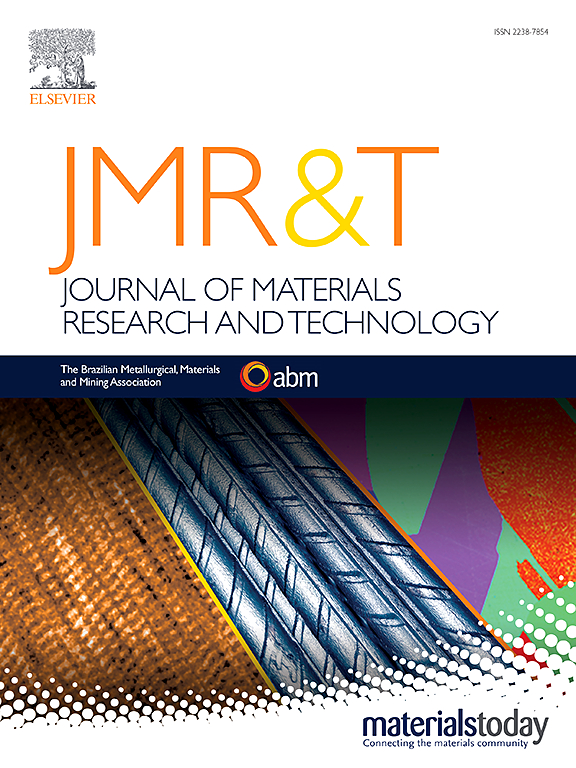碱性电解水混凝土的ph依赖性能:强度、耐久性和微观结构演变的综合分析
IF 6.6
2区 材料科学
Q1 MATERIALS SCIENCE, MULTIDISCIPLINARY
Journal of Materials Research and Technology-Jmr&t
Pub Date : 2025-06-11
DOI:10.1016/j.jmrt.2025.06.069
引用次数: 0
摘要
针对混凝土中水泥熟料含量过高造成的环境负担和二氧化碳排放问题,本研究提出了一种利用高活性碱性电解水(AEW)技术降低混凝土中水泥含量的新方法。本研究通过系统设计3种pH梯度AEW体系(9.0、10.0和11.0),研究不同pH值AEW对混凝土力学性能、耐久性和微观结构特性的影响。结果表明,与NTW相比,三种AEWs加速了水泥的水化,初始和最终凝结时间分别缩短了23分钟和11分钟。微观结构分析表明,在AEW体系中,由于离子活性的增强,水泥水化产物的形成加快,尽管pH变化的差异影响不大。AEW混凝土表现出优越的早期力学性能(pH值为10.0时最优),AEW组的强度在第3天和第28天分别比对照组提高了10%和8.5%,在养护后期增长速度有所下降。AEW样品中较低的累积汞侵入量证实了通过额外水化产物形成的微结构致密化。虽然不同pH值的AEW混凝土的性能变化并不显著,但AEW的离子吸附和OH -簇渗透性的协同作用被认为是关键机制,它们共同提高了AEW混凝土的机械强度和耐久性,从而降低了AEW混凝土的水泥熟料含量和二氧化碳排放量。研究结果可为aaw基低碳混凝土的工程推广应用提供科学依据。本文章由计算机程序翻译,如有差异,请以英文原文为准。
pH-dependent performance of alkaline electrolyzed water concrete: A comprehensive analysis of strength, durability, and microstructural evolution
Aiming to address the environmental burdens and CO2 emission issues caused by high cement clinker content in concrete, this study proposes a new approach for cement reduction in concrete through high active alkaline electrolyzed water (AEW) technology. In this study, through systematic design of three pH-gradient AEW systems (9.0, 10.0, and 11.0), the influences of AEW with different pH values on the mechanical properties, durability, and microstructural characteristics of concrete were investigated. The results showed that three AEWs accelerated cement hydration, evidenced by 23-min and 11-min reductions in initial and final setting times compared to NTW. Microstructural analyses indicated accelerated formation of cement hydration products in AEW systems, attributed to enhanced ionic activity, though pH variations exhibited little differential effects. AEW concrete demonstrated superior early-stage mechanical properties (optimal at pH value of 10.0), the strengths of AEW group increased by 10 % at 3 days and 8.5 % at 28 days than control group, with decreased growth rate during later curing stages. A lower cumulative mercury intrusion in AEW specimens verified microstructural densification through additional hydration product formation. Although the performance changes between AEW concrete with different pH values are still not significant, the synergistic effects of AEW's ionic adsorption and OH− cluster permeability were considered as critical mechanisms, collectively improve the mechanical strength, and durability of AEW concrete, which can leads to a reduction in cement clinker content and CO2 emissions for AEW concrete. The findings can provide a scientific foundation for the engineering promotion and application of AEW-based low-carbon concrete.
求助全文
通过发布文献求助,成功后即可免费获取论文全文。
去求助
来源期刊

Journal of Materials Research and Technology-Jmr&t
Materials Science-Metals and Alloys
CiteScore
8.80
自引率
9.40%
发文量
1877
审稿时长
35 days
期刊介绍:
The Journal of Materials Research and Technology is a publication of ABM - Brazilian Metallurgical, Materials and Mining Association - and publishes four issues per year also with a free version online (www.jmrt.com.br). The journal provides an international medium for the publication of theoretical and experimental studies related to Metallurgy, Materials and Minerals research and technology. Appropriate submissions to the Journal of Materials Research and Technology should include scientific and/or engineering factors which affect processes and products in the Metallurgy, Materials and Mining areas.
 求助内容:
求助内容: 应助结果提醒方式:
应助结果提醒方式:


